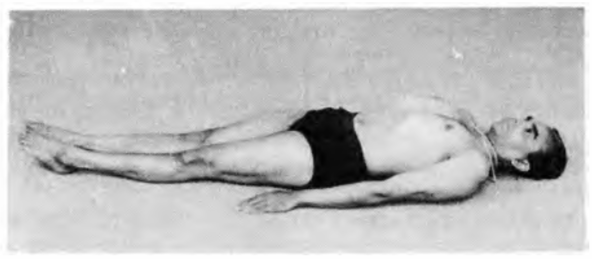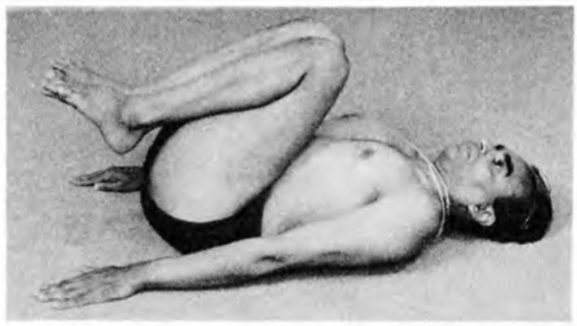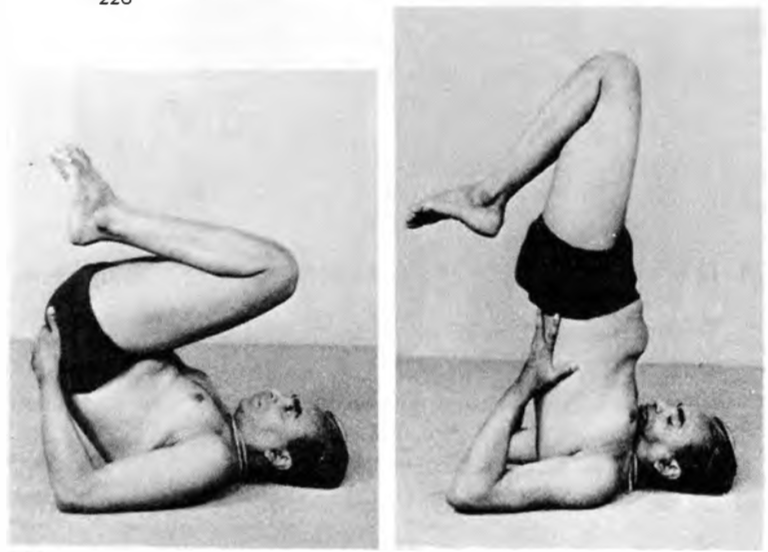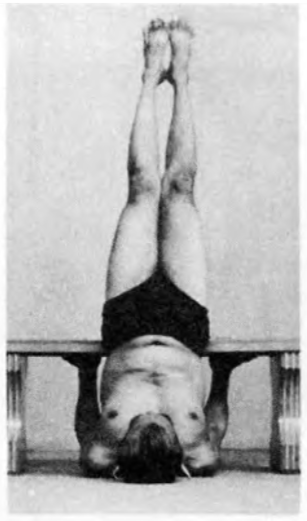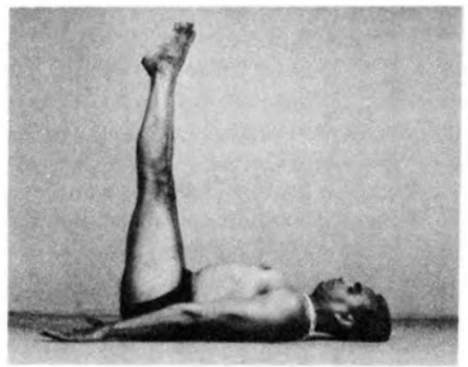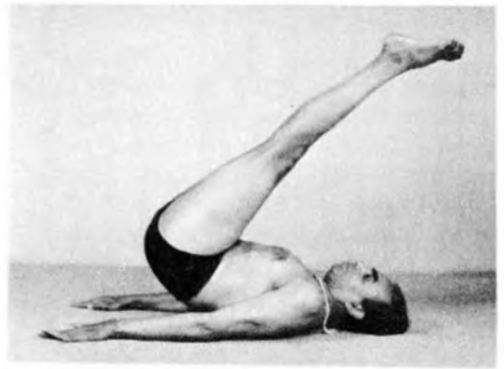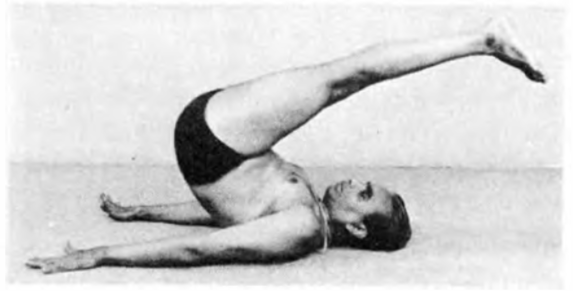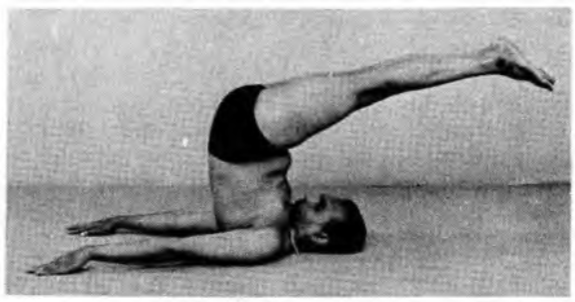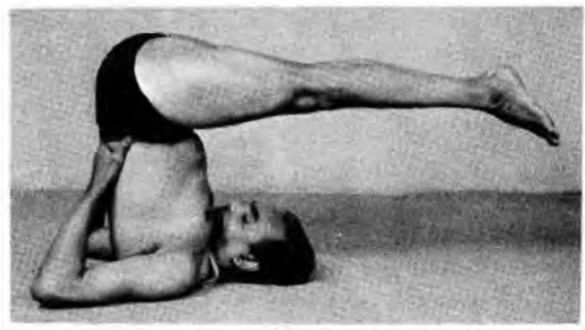Search your article
Salamba Sarvangasana I
Salamba Sarvangasana I- 2
Alamba means a prop, a support and sa together with or accompanied by. Salamba, therefore, means supported or propped up. Sarvanga (Sarva=all, whole, entire, complete; anga=limb or body) means the entire body or all the limbs. In this pose the whole body benefits from the exercise, hence the name.
Techniques for beginners
I. Lie flat on the back on the carpet keeping the legs stretched out, tightened at the knees. Place the hands by the side of the legs, palms down. Take a few deep breaths.
2. Exhale, bend the knees and move the legs towards the stomach till the thighs press it. Take two breaths.
3· Raise the hips from the floor with an exhalation and rest the hands on them by bending the arms at the elbows. (Plate 221.) Take two breaths.
4· Exhale, raise the trunk up perpendicularly supported by the hands until the chest touches the chin. (Plate 222)
5 · Only the back of the head and the neck, the shoulders and the backs of the arms up to the elbows should rest on the floor. Place the hands in the middle of the spine as in Plate 222. Take two breaths.
6. Exhale and stretch the legs straight with the toes pointing up.
1· Stay in this position for 5 minutes with even breathing.
8. Exhale, gradually slide down, release the hands, lie flat and relax.
9· If you cannot do the asana without support use a stool and follow the technique.
Techniques for advanced pupils
1. Lie flat on the back on the carpet.
2. Keep the legs stretched out, tightened at the knees. Place the hands
by the side of the legs, palms down.
3· Take a few deep breaths. Exhale slowly and at the same time raise both legs together and bring them at a right angle to the body as in Plates 226, 227 and 228. Remain in this position and inhale, keeping the legs steady.
4· Exhale, again raise the legs further up by lifting the hips and back from the floor, pressing the palms gently against the floor.
5· When the whole trunk is raised off the ground, bend the elbows and place the palms on the back of the ribs, resting the shoulders well on the floor.
6. Utilise the palm pressure and raise the trunk and legs up vertically as in Plate 233 so that the breast-bone presses the chin to form a firm chinlock. The contraction of the throat and pressing the chin against the breast-bone to form a firm chinlock is known as Jalandhara Bandha. Remember to bring the chest forward to touch the chin and not to bring the chin towards the chest. If the latter is done, the spine is not stretched completely and the full effect of this asana will not be felt.
7. Only the back of the head and neck, the shoulders and the upper portion of the arms up to the elbows should rest well on the floor. The remainder of the body should be in one straight line, perpendicular to the floor. This is the final position.
8. In the beginning, there is a tendency for the legs to swing out of the perpendicular. To correct this, tighten the back thigh muscles and stretch up vertically.
9· The elbows should not be placed wider than the shoulders. Try and stretch the shoulders away from the neck and also to bring the elbows close to each other. If the elbows are widened, the trunk cannot be pulled up properly and the pose will look imperfect. Also see that the neck is straight with the centre of the chin resting on the sternum. In the beginning, the neck moves sideways and if this is not corrected, it will cause pain and injure the neck.
10 . Remain in this pose for not less than 5 minutes. Gradually increase the time to 15 minutes; this will have no ill effects.
11. Release the hands, slide down to the floor, lie flat and relax. As the weight of the whole body is borne on the neck and shoulders and as the hands are used to support the weight this asana is called Salamba Sarvangasana. In Sarvangasana there are various movements which can be done in addition to the basic pose described above.
Effects
The importance of Sarvangasana cannot be over-emphasised. It is one of the greatest boons conferred on humanity by our ancient sages. Sarvangasana is the Mother of asanas. As a mother strives for harmony and happiness in the home, so this asana strives for the harmony and happiness of the human system. It is a panacea for most common ailments. There are several endoctrin: organs or ductless glands in the human system which bathe in blood, absorb the nutriments from the blood and secrete hormones for the proper functioning of a balanced and well developed body and brain. If the glands fail to function properly, the hormones are not produced as they should be and the body starts to deteriorate. Amazingly enough many of the asanas have a direct effect on the glands and help them to function properly. Sarvangasana does this for the thyroid and parathyroid glands which are situated in the neck region, since due to the firm chinlock their blood supply is increased. Further, since the body is inverted the venous blood flows to the heart without any strain by force of gravity. Healthy blood is allowed to circulate around the neck and chest. As a result, persons suffering from breathlessness, palpitation, asthma, bronchitis and throat ailments get relief. As the head remains firm in this inverted position, and the supply of the blood to it is regulated by the firm chinlock, the nerves are soothed and headaches-even chronic ones-disappear. Continued practice of this asana eradicates common colds and other nasal disturbances. Due to the soothing effect of the pose on the nerves, those suffering from hypertension, irritation, shortness of temper, nervous breakdown and insomnia are relieved. The change in bodily gravity also affects the abdominal organs so that the bowels move freely and constipation vanishes. As a result the system is freed from toxins and one feels full of energy. The asana is recommended for urinary disorders and uterine displacement, menstrual trouble, piles and hernia. It also helps to relieve epilepsy, low vitality and anaemia.
It is no over-statement to say that if a person regularly practices Sarvangasana he will feel new vigour and strength, and will be happy and confident. New life will flow into him, his mind will be at peace and he will feel the joy of life. After a long illness, the practice of this asana regularly twice a day brings back lost vitality. The Sarvangasana cycle activates the abdominal organs and relieves people suffering from stomach and intestinal ulcers, severe pains in the abdomen and colitis.
People suffering from high blood pressure should not attempt Salamba Sarvangasana I unless they do Jialasana first and can stay in it for not less than 3 minutes.
The Sarvangasana Cycle
These various movements can be practised at one stretch after stay ing in Sarvangasana I from 5 to 1o minutes or more accord ing to capacity; do them for 20 to 30 seconds at a time each side except Halasana, which should last from 3 to 5 minutes at a stretch.
